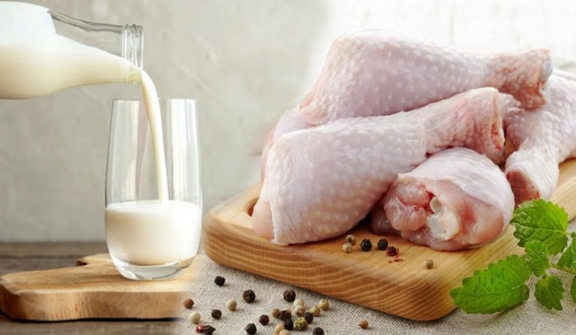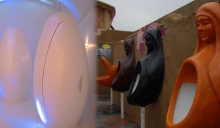
1. Eggs
Salmonella bacteria can spoil any food, especially products that are at higher risk from exposure to animal feces. In chickens, it can infect eggs before shells form, so even fresh, clean eggs can contain Salmonella.
Symptoms of food poisoning caused by Salmonella bacteria usually appear quickly, within 8 -72 hours after eating.
Patients often have abdominal pain, cramps, chills, diarrhea, fever, muscle pain, nausea, vomiting, signs of dehydration, bloody stools. Children can become severely dehydrated quickly and it can become life-threatening.
To prevent Salmonella poisoning, you should not eat raw or undercooked eggs. Choose eggs of safe origin and store them in the refrigerator at 4°C or cooler. Discard cracked or dirty eggs. Also wash your hands with soap after handling eggs.
2. Chicken
Raw chicken often contains Campylobacter and Salmonella bacteria. People infected with Campylobacter bacteria often have bloody diarrhea, fever, stomach cramps, nausea, vomiting ...
You may get food poisoning with contaminated chicken that hasn't been cooked thoroughly, or if the chicken's juices leak in the refrigerator or on kitchen surfaces.
Bacterial infections may also happen if you use a cutting board that has been used to chop raw chicken without washing it well.
To prevent food poisoning, it is necessary to buy safe and clean chicken, and do not mix raw chicken with other foods.
Wash your hands with soap before and after handling chicken. Only eat chicken when it has been thoroughly cooked, and do not eat raw chicken.

3. Ground beef
E.coli bacteria live in the intestines of cattle and can infect beef during the slaughter process. Ground beef is a high-risk food because bacteria can be transmitted during the grinding.
Symptoms of an E. coli infection include: severe abdominal pain, watery diarrhea, and vomiting. The infections usually develops a few days after exposure and can be severe in vulnerable people such as elders, young children, and people with weakened immune systems.
Like any other raw food, ground beef is susceptible to bacteria which invade and multiply rapidly. Therefore, you must cook ground beef as soon as possible to prevent harmful bacteria from entering, and it is necessary to cook the beef thoroughly to ensure safety.
4. Ham and Sausage
Sometimes Listeria bacteria "finds its way" into a food processing factory, where it can live for years. High heat can kill Listeria bacteria, but it can infect cooked foods during the packaging process.
To ensure safety, sausage and cold cuts should be thoroughly reheated. Do not eat ready-to-eat foods that have passed their use-by date.
5. Milk
There are many types of bacteria found in raw milk and raw dairy products including soft cheeses, cream and milk such as: Brucella, Campylobacter, Cryptosporidium, E. coli, Listeria and Salmonella.
Symptoms can vary depending on the type of bacteria, the amount of food and the immune system of each person. Some common symptoms are diarrhea, abdominal cramps and vomiting. In a few cases they can be serious, even life-threatening.
As a precaution, only use milk and dairy products that have been pasteurized, manufactured and stored according to standards to ensure safety.

6. Canned food
Canning is a common way to help preserve food for a long time. However, canned food also has the potential to cause poisoning as it will contain botulinum if it is improperly processed, stored and used.
Canned products from meat, vegetables, tubers, fruits, seafood that do not meet food safety conditions are at risk of being contaminated with Clostridium botulinum bacteria and producing botulinu.
Botulinum is a toxin that is produced in an anaerobic environment under unsanitary conditions. Botulinum is more virulent than the toxins of all other bacteria.
The incubation period is from 8 to 10 hours, in some cases only 4 hours with symptoms such as vomiting, nausea, headache, dizziness, fatigue, dry skin, abdominal pain, bloating, constipation; pupil dilation, loss of light reflex, myocardial paralysis...
Therefore, to ensure safety, only use safe canned products. Absolutely do not use canned products that have expired, deformed, or have unusual taste or color.
In addition, it is advisable to eat all of the canned food immediately after opening the lid, to prevent bacteria from getting in.
7. Stews and Sauces
Clostridium perfringens is a bacteria that causes cramps and diarrhea, which last less than 24 hours. Stews, gravies, sauces, and other foods that are prepared in large quantities and kept warm for long periods of time before being eaten are common sources of Clostridium perfringens infection.
To ensure health safety, sauces, gravies and stews must be cooked thoroughly and then kept at high heat, and eaten immediately after cooking.
8. Raw oysters
Vibrio bacteria live in the coastal waters where oysters live and can congregate in their tissues. When you eat raw or undercooked oysters, you are susceptible to this type of bacteria.
Most cases of Vibrio infections from oysters, such as those with Vibrio parahaemolyticus, come with diarrhea and vomiting. However, people infected with Vibrio vulnificus can get very sick and in dangerous conditions. This is because Vibrio vulnificus infection can lead to sepsis, and severe blistering skin lesions.
To prevent food poisoning caused by Vibrio bacteria, do not eat raw or undercooked oysters or other shellfish.
Some oysters are processed for safety after they are harvested. This method can reduce the level of Vibrio in oysters, but it does not eliminate all harmful bacteria.
Separate cooked seafood from raw seafood to avoid cross-contamination. Wash hands with soap after handling raw seafood.

9. Fresh Tuna
Scombrotoxin poisoning is an allergic-like result of eating fish that has already begun to spoil, including tuna, mackerel, etc.
Histamine-producing bacteria in the fish can cause a burning reaction in the mouth, itchy rashes, dizziness, headache, and diarrhea. Symptoms usually subside within 4-6 hours, and antihistamines can help.




